Swiss Railways train in Zurich Station
Romania by Train – An Adventure and a Joy
I love travelling by train. I never tire of watching the ever-changing scenery, both outside and inside the train. I have travelled on railways in all European countries from Russia eastwards except Albania, Montenegro and North Macedonia and one of my favourites is Romania.
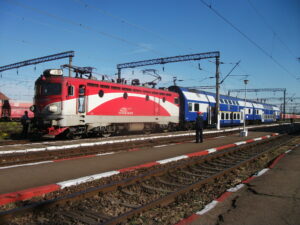
In April 2024 I explored Romania by train, travelling to and from my home in Yorkshire by train as well. It was fascinating to compare the country and its transport system with my previous dozen or so visits, the first of which was in 1995.
I travelled by LNER from Northallerton to London and Eurostar to Bruxelles for an overnight stop. The next day I took the Deutsche Bahn ICE at 08.22 to Frankfurt am Main HBF and after a short break another ICE to Vienna arriving at 18.47 for my next overnight stop. The third day was more leisurely leaving Vienna by EC train at 08.42 for Budapest from where I took the MAV (Hungarian Railways) train to Debrecen arriving at 15.52 with time to explore the city before a good meal and a good nights sleep. By checking internet timetables I had discovered a suburban service that avoided taking a bus or metro between Budapest Keleti and Nyugati and saved an hour travelling time. I left the train from Vienna at Budapest Kelenford and took the local train to Kobanya-Kizpest where I joined the Debrecen train. Over the three days the total delay was twenty minutes but I never missed a planned connection.
The next morning I took the daily train from Debrecen to Satu Mare in Romania. This included a locomotive and crew change as well as customs checks at Valea lui Mihai. From Satu Mare my trip round Romania took me through Baia Mare, Cluj-Napoca, Brasov, Ploesti, Iasi, Galati, Braila, Bucaresti, Craiova, Targu Jiu, Resita, Timisoara, Arad and Oradea.
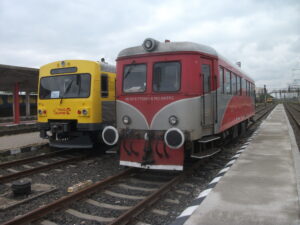
Coming home I left Oradea at 10.36 on a Monday changed at Puspokladny, Kobanya-Kispest and Kelenfold arriving in Linz at 18.28. Here I stayed in the wonderful and aptly named Lokomotive hotel. On Tuesday I left Linz at 08.34 by ICE to Frankfurt-am-Main changing onto another ICE for Bruxelles my final overnight stop, arriving at 17.35. Wednesday I left Bruxelles at 10.52 by Eurostar for London where I caught the 12.30 LNER arriving in Northallerton at 14.53. Twenty two hours travelling through six countries on eight trains with a total delay of eight minutes.
Romania is a beautiful country. I travelled through mountains, across plains, along river valleys and through forests. Cattle, sheep, goats were being tended in the fields along with the occasional pigs and deer. There was much arable farming and the range and quality of local fruit and vegetables is outstanding. Numerous villages were passed sedately. Railways came late to Romania so many stations were built on the edge of towns and cities but the massive communist programme to move people from villages into urban areas led to a building boom that extended well beyond the stations.
Cities in the western part of the country retain many of their Hapsburg era buildings whilst the east shows its Ottoman influence. Move away from the city centres by tram or trolleybus and the communist era buildings are very evident. My hotels ranged from Hapsburg opulence through communist functionality to the very modern. All were spotlessly clean, well equipped, comfortable and welcoming. The array of restaurants was truly international but I sought out those serving local cuisine and was richly blessed with excellent food.
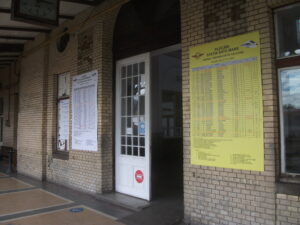
Travelling by train in Romania is a delight and very easy. I was travelling on a Global Inter-rail ticket which enabled me to board any train operated by the state run national rail company CFR and some, but not all, private operators. I was never asked for a seat reservation ticket, even on trains where it is supposed to be compulsory. Buying tickets in Romania for all operators is very easy. Stations usually have separate windows for purchasing each operator but in some cases private operators only sell tickets on the train. However all operators sell tickets on the train mainly by cash and at the same price as station ticket offices.
Most stations do not have any electronic train information displays. They rely on a poster showing all arrivals and departures. This is produced for the December timetable change and manually updated thereafter. Always check it, preferably on arrival, for timing changes. If the word ‘annulat’ is shown the train is cancelled. CFR’s online timetable is so easy to use that I did not bother to use the English version. It updates in real time and for limited stop trains it automatically shows minutes late or early at the last station whether it stops there or not. The only frustration is that it does not show all private operators. Not to worry, a quick internet search will enable you to find a rail map of Romania that shows who operates which line. You can then go to the appropriate website.
There is a massive amount of engineering works on the railway, usually of several hundred kilometres at a time and lasting years. Often this means extensive single line operation. Although this is included in the schedules it inevitably leads to delays. No need to worry, connecting trains always wait for delayed trains. Most lines have a sparse timetable so connectivity is paramount. Train speeds are often around 20mph over a journey, occasionally reaching 40mph and rarely 60mph giving plenty of time to enjoy the journey and make it easy to photograph the scenery.
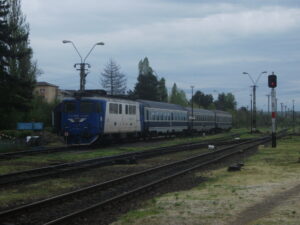
Sadly station buffets and restaurants have virtually disappeared as have train buffet and restaurant cars. However most stations have a range of convenience stores and bakeries, along with other shops, in and around them making it easy to stock up before travelling. On some long distance trains people will come through the train selling religious icons, practical items such as pens and notebooks, packeted snacks and a whole host of other items.
If your image of Romania is still in the 1990’s it needs updating. On this trip I did not see any street children, rough sleepers, drug addicts or obvious prostitutes anywhere. The handful of drunks I saw were causing no harm to anyone except themselves.
At many railway stations it is quite normal to walk across the tracks to reach platforms. Railway lines are rarely fenced and it is quite normal for people to walk alongside or across tracks anywhere. Romania is blessed with an enormous number of unstaffed halts. Often these are at an ungated level crossing on a road near a village where the train will stop across the road effectively operating as crossing gates whilst people climb off or on the train. At these halts and many others, even in quite large towns, platforms are no higher than the rails making boarding and alighting a challenge for many.
Romanians are good fellow travellers. They know how to stack luggage. It is extremely rare to see luggage on a seat or on the floor blocking a seat. They help each other stow and retrieve luggage. I never saw rubbish left on a train. Passengers tend to keep themselves to themselves but if you ask for information they will help if they can and then want to know why you are visiting their country. On the odd occasion a train conductor was trying to tell me something but didn’t speak English other passengers acted as translators. The main downside of travelling by train in Romania is that smoking is allowed anywhere on station platforms and in the vestibules of carriages. It is sad to see so many carriages and DMU’s covered in graffiti which the operators seem powerless to stop.
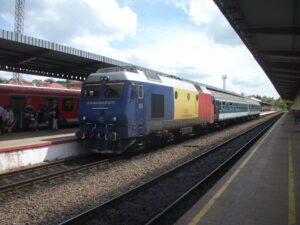
And now a word to those for whom the means of travel is as important as the travelling. The Desiro’s CFR bought in the early 2000’s have proved to be unsuitable for the intercity and interregional routes they were bought for and are now largely confined to minor local services. A few communist era railcars survive in CFR service but most services are locomotive hauled. This ranges from a locomotive hauling a singe double-deck coach to a train of eight or nine coaches, maybe more. Electric propulsion is used wherever possible with replacement by diesel locomotives when necessary. Most of the coaches I travelled in were of Deutsche Bahn origin, refurbished and repainted into the current CFR livery. Some private operators still use former SNCF DMU’s, often still in an SNCF livery. However most now use former DB DMU’s often still in full DB livery complete with local branding.
Many stations have plinthed steam locomotives on display. A significant number of stations, away from major centres, have rows of derelict wagons or coaches, and in some cases loco’s in sidings. Some have been there so long that trees are growing through them. Resita has a museum of steam locomotives all plinthed in a grassed area beside the main road through the town. A footpath runs through them. None of these, or any other plinthed loco I saw had been attacked by the graffiti vandals.
All stations are open access, automatic barriers non-existent. The one exception Is Bucaresti Nord which has gates that could be deployed but weren’t during my visits. Ticket checking is on the trains not the station and takes place after every stop. Most trains have at least two conductors. People are used to sitting in waiting rooms or on platform benches for long periods waiting for trains. Rail staff are friendly and helpful and photography at stations is no problem. One surprising difference from previous visits was that, whilst often quite basic, train toilets were generally clean, often more so than in the UK.
I had a wonderful time and hope to make another visit.
Ian Ring








